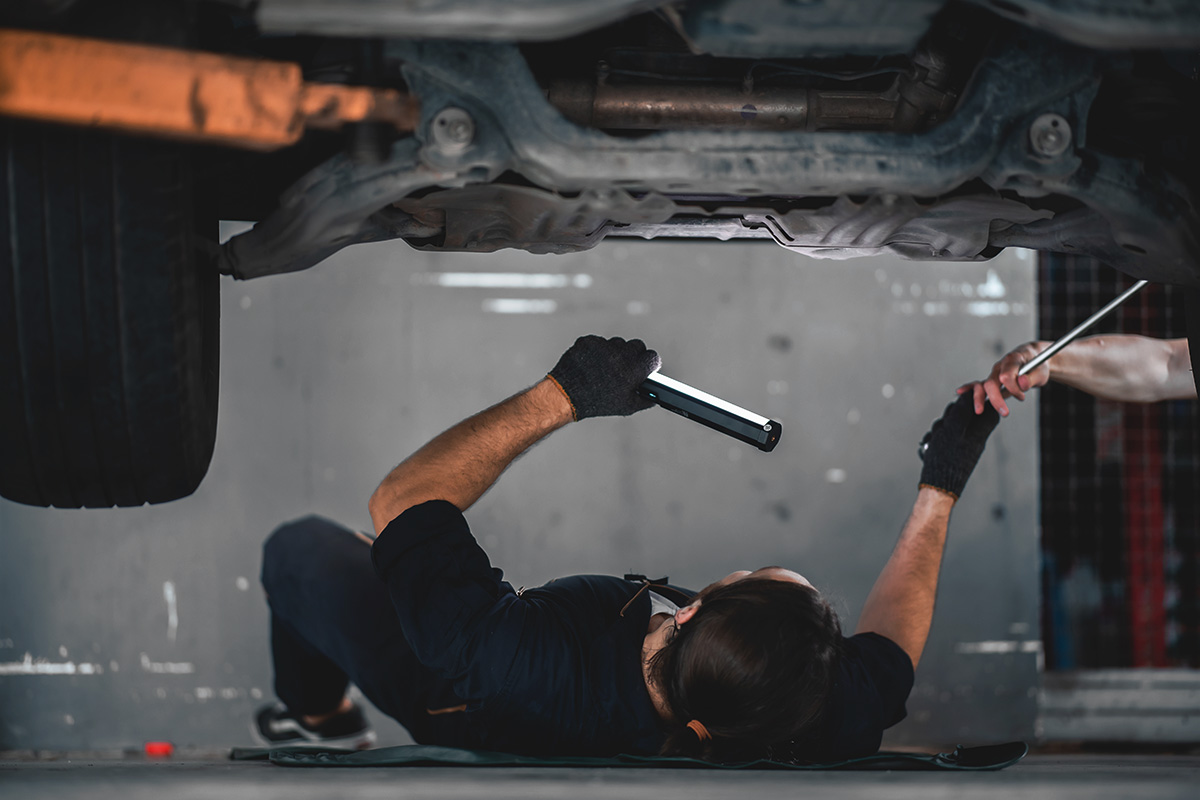If you’re leaking antifreeze but aren’t overheating, or if your car leaks antifreeze when it’s parked, you still have a chance to save money on repairs. If you keep driving with low antifreeze in your automobile, it will eventually overheat.
Overheating an engine can lead to extra difficulties, especially if you leave it running for too long and crack the block. A radiator cap leak, an internal coolant leak, or an external coolant leak are all possibilities. The longer you wait, the more expensive it will be to remedy a coolant leak. Find out how to identify an antifreeze leak and what to do next.
Determine what is causing your coolant to leak
The reasons for coolant leaks can be boiled down to three main causes, each of which differs in terms of other possibilities and the level of the harm. If you’ve observed an accumulation of coolant under your vehicle recently, or if the reservoir tank isn’t as high as it typically is, these could be symptoms that your system is leaking slowly. Another indicator of a leak is if your vehicle’s engine suddenly overheats; if it’s leaking, there may even be a coolant odor. It is not difficult to determine the sort of leak in your coolant system; however, locating it can be tricky. Every other time a person puts fuel in their gas tank, it is a good idea to check the coolant reservoir tank.
Causes of Antifreeze Leaks
The following are some of the most typical reasons for coolant leakage:
LEAKS IN THE RADIATOR CAP
If your radiator cap no longer fits properly or is weak and worn out, it might leak coolant into your system through the overflow tube, and this will happen every time you run the engine for an extended period of time. The radiator was designed to be pressurized, therefore if the radiator cap fits poorly, improperly fitting, or is not the correct cap for your radiator, pressure will be lost in either case, and this let go for an extended period of time could cause damage to a hose, necessitating even more repairs. A pressure test on the radiator cap will aid in the diagnosis of the problem.
Simply swap out your radiator cap for one that fits properly. You can discover out what the right cap is and what your pressure should be in your vehicle’s manual.
THERE HAS BEEN AN INTERNAL LEAK
For starters, if it’s an internal leak, there won’t be a pool of coolant under the car; instead, you’ll be constantly adding water to the radiator as it swiftly overheats and either leaks out or evaporates. Look at the head (cylinder block) for internal coolant leaks; it’s also possible that you have a leaking head gasket, which will allow the coolant to escape. Unless you know how to disassemble your engine, take your vehicle to an auto repair shop for diagnosis.
EXTERNAL LEAKAGE
If the problem is an exterior leak, it will be the easiest to pinpoint. If you have an exterior leak, the vehicle’s coolant will usually escape quickly, causing the vehicle to overheat quickly. By simply looking about, you should be able to figure out where the leak is. It could be a leaking hose or a radiator hole. Solution: Check to see if any coolant is leaking from your hoses. If you find coolant flowing out of the hose(s), replace them. It’s a simple fix if you find coolant leaking from your thermostat. The cost of replacing a vehicle’s thermostat is between $10 and $15, and it’s one of the simplest repairs you can make yourself. However, if your water pump is leaking coolant, things can get a little more expensive. To replace your water pump, you or an auto professional may need to purchase a water pump replacement tool from the dealership, depending on your vehicle.
GASKET FOR A BLOWN HEAD
If you’re having trouble locating the source of your coolant leak, it could be due to a burst head gasket. The engine block and cylinder heads are sealed by the head gasket. A blown head gasket might result in a large coolant leak and overheating, or a minor leak that is difficult to detect. Worse, the coolant may try to mix with the oil in your engine. If this happens, your automobile will most likely lose all compression and you will be unable to drive it. Solution: If you have a blown head gasket, you should replace it right away. Because it will necessitate considerable disassembly of your engine, the labor cost will almost always surpass the cost of the part.
Other Causes of Coolant Leaks
The following items can also allow coolant to escape:
- Core of the heater
- Water pump has a leak.
- Engine plugs that have frozen
- Thermostat malfunction
- The coolant reservoir has a crack.
- Your radiator has a hole in it
- Coolant hoses that aren’t working properly
A visual inspection, on the other hand, can easily diagnose these. It’s also possible that there’s a crack in the coolant reservoir. The coolant is a component of the car’s main system; it aids in keeping the engine cool and is unlikely to cause the vehicle to overheat; nonetheless, it may be the cause of a pool of coolant under the vehicle when it has sat for an extended period of time.
What Does Your Vehicle’s Cooling System Do?
A vehicle cooling system is critical to your vehicle’s efficient operation, and if your car’s coolant leaks, it will impact its efficiency and, in general, the way it operates, and it will gradually begin to overheat. The objective of the vehicle’s coolant system is to prevent the engine from overheating, and it accomplishes this by circulating coolant through the engine via pipes and a radiator. When the car is running, the coolant temperature progressively rises, allowing the coolant to expand and flow into the reservoir via rubber hoses. Furthermore, if the system begins to malfunction, it is critical to have it repaired as quickly as possible; otherwise, you risk incurring costly repairs. Don’t panic; coolant leaks are one of the most common engine problems and are easily repaired.
Coolant Leaks: 5 Signs and Symptoms
There are a few telltale indications to look for if you want to discover coolant leaks early and save your vehicle from damage. When your heater won’t turn on, the temperature gauge is high or low, the coolant light is on, you smell something sweet, or you’ve lost some fuel efficiency, these are all signs that something is wrong.
THE HEATER IS NOT WORKING
The coolant that keeps your engine cool powers the heater in your automobile or truck. When your heater won’t turn on, it’s a sign that either your car doesn’t have enough coolant or there’s a clog. If you believe your heater isn’t producing as much heat as it should, get your vehicle’s coolant and heating system evaluated.
HIGH OR LOW TEMPERATURE GAUGE
When the temperature in your vehicle rises or falls from its typical level while you’re driving, it could indicate an issue with the coolant system. Problems might range from the seemingly insignificant, such as a low coolant level, to the more problematic, such as a clogged radiator or a malfunctioning cooling fan. To avoid damage to your car, it’s critical to have this type of problem checked out as soon as possible. The components of your motor, as tough as metal is, can easily become too hot and melt, split, seize, or entirely fail, resulting in pricey repairs.
YOUR COOLANT LIGHT HAS TURNED ON
Engine temperature warning lights are standard in most current automobiles. They commonly resemble a wavy-lined temperature gauge. Its function is to alert you to the fact that your engine is overheating and that you should pull over. Large amounts of coolant may have spilled out due to a cracked or broken hose. Read on to learn what to do if your automobile overheats.
SOMETHING SWEET CAN BE SCENTED
Antifreeze has a pleasant smell, so if you notice something exceptionally sweet following a temperature warning or steam billowing from your hood, it’s most likely your coolant. This is an excellent time to start looking under your vehicle for visible leaks. Remove the radiator cap only when your vehicle has totally cooled down, which could take up to 45 minutes.
ECONOMY OF FUEL HAS REDUCED
Engines are built to operate under extremely precise conditions. They work optimally and get the best mileage at specified temperatures. It won’t use the fuel correctly if it’s too cold, and you won’t obtain the fuel economy you expect. Bring your vehicle in to be looked out if you’ve noticed a decrease in your gas mileage.
Is It Possible To Drive A Car With A Damaged Radiator?
No, you should never drive a car with a substantial volume of coolant leaking or a broken radiator. If your vehicle’s cooling system fails, it will overheat, causing catastrophic engine damage. Overheating engines can cause cylinder heads to deform, your engine to seize, cylinder head gasket failure, or a crack in the engine block. All of these repairs are incredibly costly, and you should avoid driving your vehicle at all costs. Have it towed to a reputable car repair facility and repaired.
How much does it cost to fix a coolant leak?
The cost of repairing a coolant leak varies depending on the type of vehicle and the cause of the leak. Antifreeze leak repair should cost between $90 and $115, according to AutoServiceCosts.com. The expenses may be lower or greater depending on what’s wrong with your antifreeze coolant system. Coolant leak repair prices will be greater for high-performance or exotic automobiles because replacement parts for these vehicles are often more expensive. Please call Bridwell Automotive Center at (480) 948-4781 to arrange an appointment to learn more about how much your coolant leak examination will cost, as well as a repair quotation.
Bridwell Automotive Car Diagnostic Tests In Scottsdale, Arizona
Our dedicated team of ASE Master Technicians will tune-up your vehicle quickly and within your budget. You can schedule your tune-up with Bridwell Automotive Center by using our contact form. Stop by our Automotive Repair Shop in Scottsdale located at 7171 E Lincoln Dr. Scottsdale, Arizona 85253 or by giving Bridwell Automotive Center a call today (480) 948-4781.





